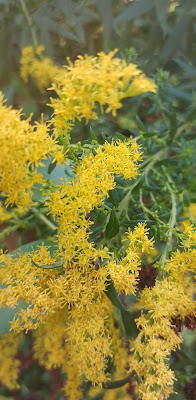Nature's Golden Touch: How to Dye Cloth with Goldenrod
I've always wanted to try this.... I have a ton of goldenrod, and I even happen to have alum. So, now I just need to get up and do it.
In the world of natural dyes, goldenrod (Solidago spp.) stands out as a vibrant and sustainable option. This bright and cheerful wildflower, often found in meadows and along roadsides, can be transformed into a beautiful and eco-friendly dye for fabrics. In this blog post, we'll take you through the process of dyeing cloth with goldenrod, enabling you to infuse your textiles with the warm, golden hues of this lovely plant.
What You'll Need
Before we dive into the dyeing process, let's gather the necessary materials:
Fresh or Dried Goldenrod Flowers: The key ingredient, goldenrod flowers, can be collected in late summer or early fall when they are in full bloom. You can also use dried goldenrod if fresh flowers are not available.
Fabric: Choose natural fibers like cotton, linen, wool, or silk for the best results. Make sure the fabric is clean and free from any finishes or coatings.
Mordant: A mordant is a substance that helps the dye adhere to the fabric and enhances colorfastness. Alum (potassium aluminum sulfate) is a commonly used mordant for natural dyeing.
Large Pot: You'll need a stainless steel or enamel pot dedicated to dyeing. Avoid using aluminum pots, as they can react with the mordant and affect the color.
Stirring Utensils: Wooden or stainless-steel spoons for stirring the dye bath.
Strainer or Cheesecloth: To strain the dye solution.
Rubber Gloves: To protect your hands from staining.
Plastic or Glass Containers: For preparing mordant solutions.
Water: Preferably soft water; hard water can affect the dye results.
The Dyeing Process
Now that you have your materials ready, let's get started with the goldenrod dyeing process:
Step 1: Preparing the Fabric
Wash your fabric in warm water to remove any sizing or impurities that might hinder dye absorption. If using wool or silk, soak the fabric in water for a few hours before dyeing.
Step 2: Preparing the Mordant
Dissolve the alum mordant in a separate container. Typically, use about 15-20% of the weight of the fabric in alum. For example, if you have 100 grams of fabric, you'd use 15-20 grams of alum. Stir until fully dissolved.
Step 3: Mordanting the Fabric
Add your fabric to the mordant solution and gently simmer for 1-2 hours. Make sure the fabric is fully submerged. Allow it to cool, then rinse it thoroughly to remove excess mordant.
Step 4: Preparing the Goldenrod
Collect a generous amount of goldenrod flowers, both the blooms and leaves. Chop them into smaller pieces to release more color during the dyeing process.
Step 5: Creating the Dye Bath
Place the chopped goldenrod in your dye pot and cover it with enough water to fully submerge the plant material. Simmer this mixture for about an hour to extract the dye. You'll notice the water turning a golden hue.
Step 6: Straining the Dye
Strain the goldenrod liquid to remove any plant material, leaving you with a clear dye bath.
Step 7: Dyeing Your Fabric
Place your pre-mordanted fabric into the dye bath and simmer gently for 1-2 hours. Stir occasionally to ensure even dye absorption. The longer you simmer, the deeper the color will be.
Step 8: Rinsing and Care
Once you achieve your desired color, remove the fabric from the dye bath and rinse it until the water runs clear. Allow it to air dry, and voilà, you've successfully dyed your cloth with goldenrod!
Dyeing cloth with goldenrod is a rewarding and sustainable way to infuse your textiles with the warm and inviting colors of nature. By following these steps and experimenting with different fabric types and dye concentrations, you can create unique and beautiful pieces of clothing or home decor while also connecting with the natural world. Goldenrod dyeing is not only a creative endeavor but also an eco-friendly choice that celebrates the beauty of the great outdoors.


Comments
Post a Comment